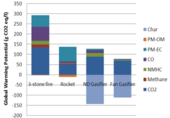Highlight
Engineer and Economist Introduce a Common Language for Greater Scientific Impact on Policy
Achievement/Results
John Field and Sam Evans, NSF IGERT scholars in the Multidisciplinary Approaches to Sustainable Bioenergy at Colorado State University, developed a method to evaluate the ability of advanced improved cookstoves to reduce the amount of greenhouse gases (GHGs). This collaboration between John, a Mechanical Engineering PhD student and Sam, a PhD student in the Department of Agricultural and Resource Economics, resulted in a new way to evaluate the effectiveness of improved cookstoves by integrating technological and economical analyses into their study. These insights will be very useful to not only the cookstove engineer developers and producers, but also to policy-makers who are interested in realizing the potential of cookstoves to reduce GHGs and our carbon footprint.
Sam and John introduced a cost-benefit analysis, a traditional economics tool used by governments to measure the cost of something balanced by the benefits to see if the benefits outweigh the costs, to facilitate the translation of technology development to government policy. In the US and other countries, governments evaluate decision outcomes by placing value on something relative to the expense compared to the expected returns. Simple effort vs. reward. This study is a critical link between scientific technology and policy by incorporating language that will directly impact governmental policy. Often, communication between scientists and policy-makers can be disjointed. This miscommunication can be due to scientists not including concrete elements in their research that policy-makers understand, and thus, these elements may not be factored into policy decisions. Therefore, it is imperative for scientists to incorporate not only language that policy-makers understand in their research results, but also types of analyses that policy-makers will utilize in their decisions, such as cost-benefit analyses. In other words, scientists and policy-makers need to share some of the same language for policy to include well-created scientific studies and science to include solid societal analyses based upon policy. This interdisciplinary study begins to bridge this gap.
In their study, John and Sam investigated several cookstove types of varying technologies (from basic to more sophisticated models) to evaluate the ability of each stove type to reduce GHG emissions by performing a cost-benefit analysis along a gradient with each cookstove type (Figure 1). The costs were the actual costs of the stoves and the benefits were measured by the ability of new stoves to emit less GHGs, and importantly, also how the stoves allow for reduction of carbon by reusing the stove by-products such as biochar. Newer stoves such as the ND gasifier and Fan gasifier produce char as a byproduct (biochar), a substance that can be added to soils to increase the soil viability and has been linked to greater crop yield and carbon sequestration (or carbon capture), thus reducing the amount of carbon in the atmosphere and balancing out the GHG emissions produced by the newer stoves. Therefore, the newer stoves seem to reduce the GHG emissions.
As mentioned above, costs were the actual cost of the stoves, and the benefit component was the ability of the stoves to reduce GHG emissions (as explained above). These two measures translated into the cost-benefit amounts per stove estimated by the cost (average price) divided by the benefit (avoided emissions) (Table 1). The take-home message with results from this table is that cost-benefit values are very similar for all three stoves, and thus are comparable technologies in policy language.
By introducing cost-benefit analyses to their study, John and Sam have allowed policy-makers who may not be technologically skilled to knowledgeably interpret the results in a language they understand. Further, if a policy-maker were involved in environmental issues, he or she could then start to make more specific decisions on the type of technology to incorporate based upon the specific elements involved. This is an exciting study because this cost-benefit approach could be applied to other technologies to help illustrate societal benefits, which in turn helps policy-makers make scientifically informed decisions. Without the intrinsic interdisciplinary nature of the IGERT program, this type of integrated study, in which an engineer and an economist can communicate on a common project, would most likely not have happened.
Address Goals
Discovery: a new analysis tool was developed. Learning: a model for interdisciplinary research was created.







